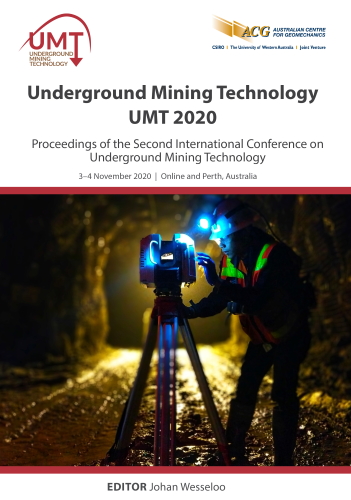A new stope reconciliation approach

|
Authors: McFadyen, B; Woodward, KR; Potvin, Y; Grenon, M |
DOI https://doi.org/10.36487/ACG_repo/2035_17
Cite As:
McFadyen, B, Woodward, KR, Potvin, Y & Grenon, M 2020, 'A new stope reconciliation approach', in J Wesseloo (ed.), UMT 2020: Proceedings of the Second International Conference on Underground Mining Technology, Australian Centre for Geomechanics, Perth, pp. 335-350, https://doi.org/10.36487/ACG_repo/2035_17
Abstract:
Open stope mining remains the most widely used method for the underground extraction of hard rock metalliferous deposits since mines became increasingly mechanised from the early 1980s. One of the most significant factors that influence the value creation and profitability of open stope mining is linked to the ability of the mining process to accurately extract a designed stope. The performance of a stope is quantified during a reconciliation of the achieved excavation with respect to a planned geometry. Deviations from a planned stope volume can be categorised as material unintentionally mined (overbreak) or material intended to be mined but not recovered (underbreak). Conceptually, minimisation of both cases is important to mine economics as overbreak represents extra costs of mining waste while underbreak represents lost value from the sterilisation of ore. This paper describes a new approach for stope reconciliation that facilitates the identification of the root causes of overbreak and underbreak at three progressively finer levels of detail. This is achieved by quantifying stope performance with respect to the entire stope, individual stope faces and octree blocks. The reconciliation of an entire stope volume is systematically performed at most open stope mines and is often complimented by the reconciliation by individual stope faces. The octree analysis is a novel stope reconciliation technique that subdivides stope volumes into small blocks (usually <1 m). The sparse grid structure of this analysis enables the investigation to understand the relationship between stope performance and multiple factors such as blasthole standoff distance, orientation and blasting energy, effective radius factor, distance to development, distance and orientation to faults, and distance to convex hull. Stope reconciliation on a per octree basis assesses the stope at a resolution where the variation of performance and influencing factors can be captured and investigated.
Keywords: stope design, stope reconciliation, overbreak, underbreak
References:
Clark, L 1998, Minimizing dilution in open stope mining with a focus on stope design and narrow vein longhole blasting, MSc thesis, University of British Columbia, Vancouver.
Mathews, KE, Hoek, E, Wyllie, DC & Stewart, SBV 1981, Prediction of stable excavation spans for mining at depth below 1,000 m in hard rock mines, Report to Canada Centre for Mining and Energy Technology, Ottawa.
Miller, F, Potvin, Y & Jacob, D 1992, ‘Laser measurement of open stope dilution’, CIM Bulletin, vol. 85, pp. 96–102.
Potvin, Y, Grant, D, Mungur, G, Wesseloo, J & Kim, Y 2016,‘Practical Stope Reconciliation in Large-scale Operations Part 2, Olympic Dam, South Australia’, in C Carr & G Chitomobo (eds), Proceedings of the Seventh International Conference & Exhibition on Mass Mining, Australasian Institute of Mining and Metallurgy, Melbourne, pp. 501–509.
© Copyright 2025, Australian Centre for Geomechanics (ACG), The University of Western Australia. All rights reserved.
View copyright/legal information
Please direct any queries or error reports to repository-acg@uwa.edu.au
View copyright/legal information
Please direct any queries or error reports to repository-acg@uwa.edu.au
